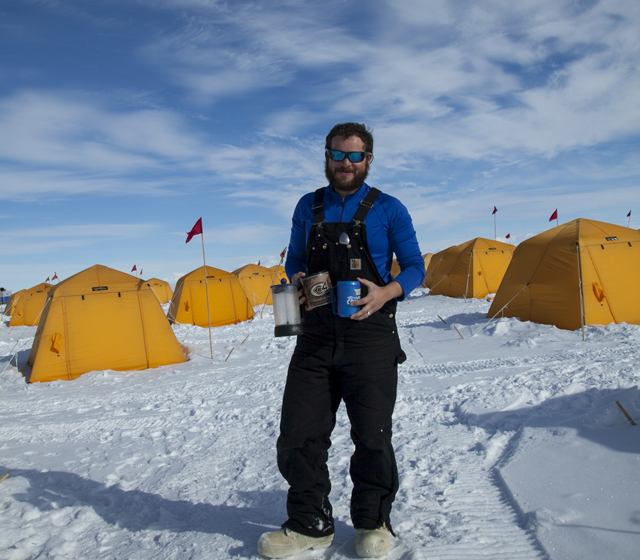16 November 2020–Costa Rica is home to about 15,000 earthquakes a year, and its citizens are well-educated when it comes to the science behind all the seismic activity, says Esteban Chaves.
“If you ask a Costa Rican where the subduction zone is, they are able to respond. Most of them can tell you if an earthquake has occurred in a local fault or the subduction zone,” he says. “It’s a process we need to get used to and live with, because Costa Rica is one of the most earthquake-prone countries in the world.”
As a child in Costa Rica, Chaves was already curious about why the Earth trembles. While pursuing his undergraduate degree in natural sciences and physics, the curiosity grew after attending a lecture by fellow seismologists, now colleagues, that got him wondering about the difference between small and large earthquakes, “why they start in a similar fashion but something happens along the way and they become a magnitude 7 or a magnitude 3,” he recalls.
Today he works as a researcher at the Volcanological and Seismological Observatory of Costa Rica (OVSICORI). The institute, part of the Universidad Nacional de Costa Rica (UNA), has become a world-renowned seismological research facility in part because Chaves and his colleagues have blanketed the country with more than 80 broadband stations. “It’s by far the densest and most-state-of-the-art seismic network in Latin American,” Chaves says.
Many of these stations have been in operation for more than 20 years in the Nicoya Peninsula on Costa Rica’s west coast. The peninsula bears the brunt of the collision as the Cocos tectonic plate dives beneath the Caribbean plate. “The subduction rate there is really fast—about 85 millimeters per year—and generates large earthquakes about every 50 years,” Chaves says.
The seismic network on the peninsula offers a unique opportunity for Chaves and his colleagues to study the source evolution of earthquakes, including their dynamic rupture, how they behave over time, how they propagate and how they affect the surrounding region. In particular, the researchers have used small repeating earthquakes—earthquakes that rupture the same fault patch and generate very similar waveforms—on the peninsula as a natural experiment to look these factors.
Recently, Chaves and colleagues looked at five families of repeating earthquakes before and after a magnitude 7.6 Nicoya earthquake in 2012, measuring stress drop—how much stress is released after an earthquake occurs—for the five families. All five showed a systematic decrease in stress drop after the 2012 quake. “Changes in stress drop are related to how a fault is weakening and healing over time,” Chaves explains. “With the repeating earthquakes, for the first time we could observe this in nature. Before this, we only had observations from laboratory experiments.”

“Because we have so much instrumentation on the peninsula, we are able to see in high detail what’s happening in the megathrust,” he added. “Now we can start thinking about these changes and maybe in the future relate these changes to hazard prediction.”
Chaves and his colleagues are now working on replicating some of the same experiments on the Osa Peninsula in southern Costa Rica, where plate collision is even faster and large earthquakes occur every 40 years. The researchers have plans to drill down to physically sample the plate interface here, because it lies only five kilometers deep.
“We can do multiple things with this data, look at the structure of fault, how heterogeneous is the fault, what is its geometry, if there are corrugations, what is the fluid content of fault,” Chaves says. “These kinds of mechanical things can help us understand earthquake nucleation.”
Working at OVSICORI requires a broad skill set, as there are about only ten seismologists covering the whole country, Chaves notes. “The whole network is installed by seismologists, not engineers, so we need to get dirty. We need to go to the field, dig the holes and install the stations ourselves.”
At the same time, Chaves works on public outreach, fields media inquiries and helps to maintain OVSICORI’s impressive social media channels. “People from Panama and Nicaragua follow our social media to know more about earthquakes in their countries,” he says.
Chaves is interested in developing machine learning to get more out of Costa Rica’s massive seismic data set, starting with an effort to create seismic catalogs automatically instead of by hand. He is collaborating with other universities in Costa Rica to explore using publicly available algorithms for machine learning in seismology. “One of the projects that I would like to work on would be to explode the earthquake catalog even more, and extract as many events as we can,” he says. “ We want to know where are the areas where seismicity is being generated, or elastically coupled and prone to generate earthquakes in the future.”
International collaborations are a significant part of Chaves’s work at the observatory. He and his colleagues work with researchers at ETH Zürich on earthquake early warning systems, nuclear monitoring with the Comprehensive Nuclear-Test-Ban Treaty Organization and a slew of international scientists on a 2020 paper showing worldwide seismic “quiet” in the wake of the COVID-19 pandemic lockdown.
The paper has renewed interest in Costa Rica’s seismic riches—a trend that Chaves hopes will continue. “I’d like to put out a call,” he says. “We have this beautiful seismic network, so if you want the data, just let us know and we’re happy to collaborate with you!”
SSA At Work is a monthly column that follows the careers of SSA members. For the full list of issues, head to our At Work page.
